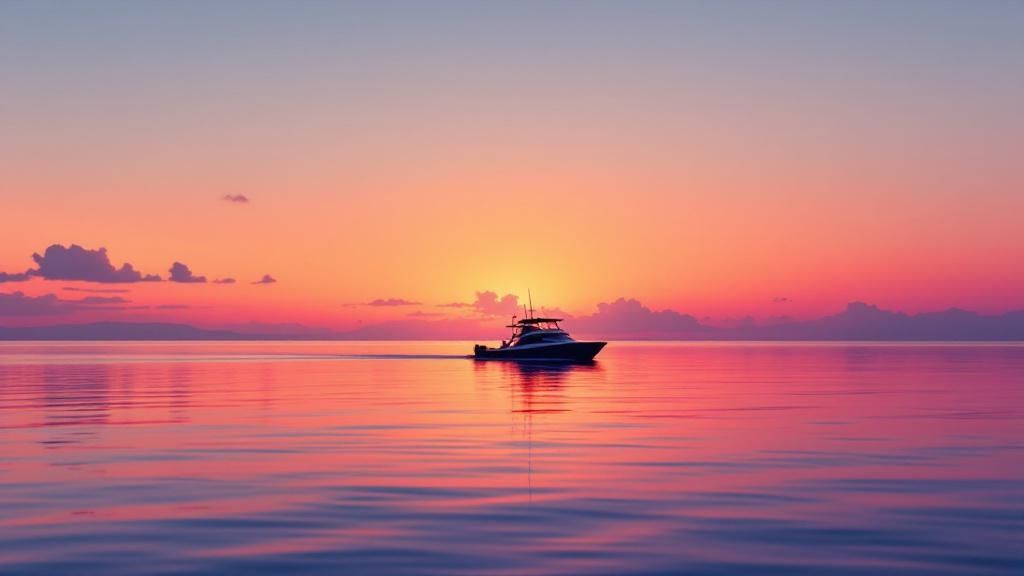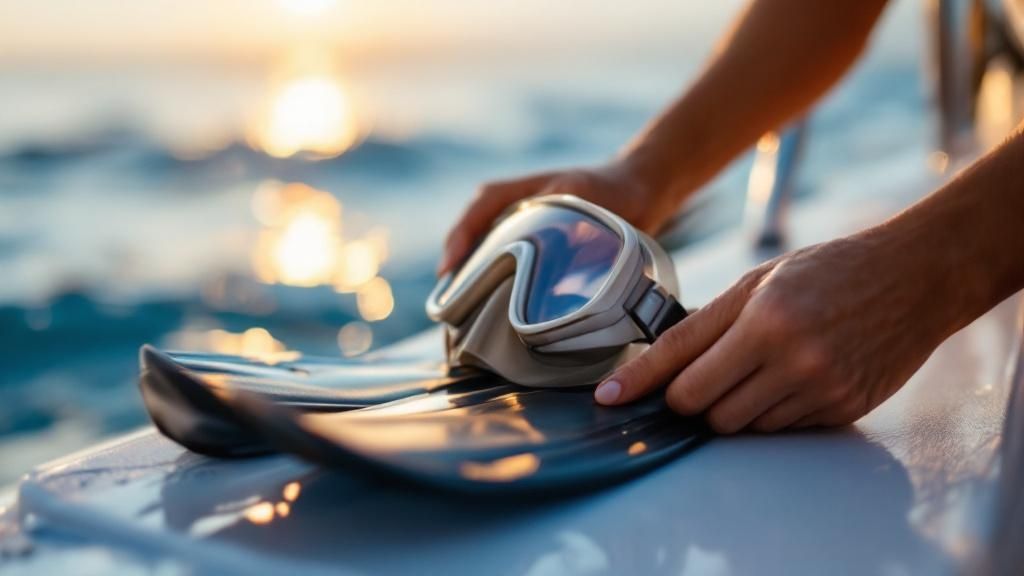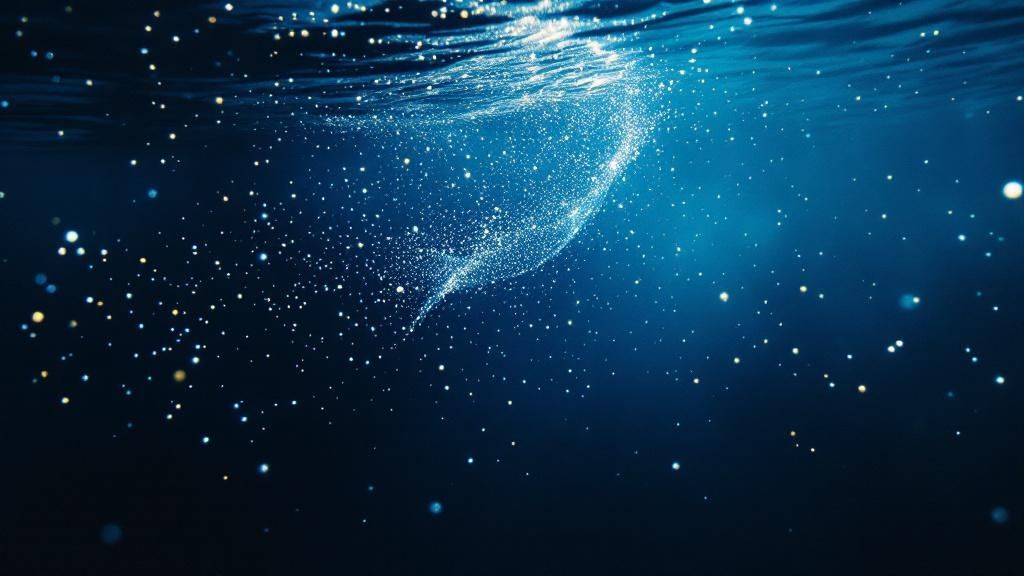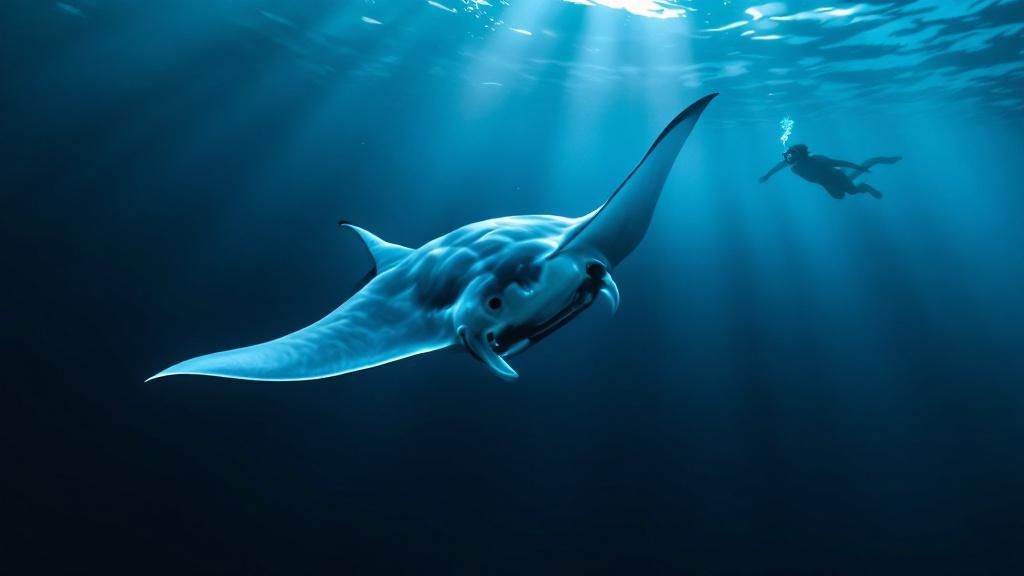Manta Ray Snorkel Big Island | Ultimate Guide & Tips
- Byron
- Jul 29
- 14 min read
Picture this: you're floating on the calm, dark ocean just as the sun disappears. Then, a massive, graceful shape with an incredible wingspan glides into the light below you—a giant manta ray, performing a silent underwater ballet. This is the magic of the world-famous manta ray snorkel Big Island experience, a true bucket-list adventure for travelers across the globe.
As a top local operator, Manta Ray Night Snorkel Hawaii gives you an incredible front-row seat to this natural show, and our guests constantly tell us it was the highlight of their whole trip.
Your Ultimate Guide to the Big Island Manta Ray Night Snorkel

Here on the Big Island of Hawai'i, you can have one of the most unique and breathtaking wildlife encounters on the entire planet. What makes it so special is that it happens after dark, creating a surreal and almost otherworldly atmosphere.
This guide will break down everything you need to know. We’ll cover the science behind the snorkel and help you choose the right tour, ensuring you have an unforgettable—and safe—experience.
Why Is Kona the Manta Ray Capital of the World?
The Kona coast isn't just a decent place to see manta rays; it's hands-down the most reliable spot on Earth. It all comes down to a perfect storm of conditions that create a "manta magnet." The underwater landscape, sculpted by ancient volcanoes, creates nutrient-rich waters that fuel a huge amount of plankton, which happens to be the manta rays' favorite meal.
This dependable food source has nurtured a thriving local population of over 450 identified reef manta rays. These gentle giants don't migrate, so Kona is their permanent home and feeding ground. Because of this, tour operators see an incredible 85-90% sighting success rate, meaning your chances of witnessing the spectacle are exceptionally high. You can learn more about Kona's unique manta environment over at konahonudivers.com.
Key Takeaway: The Big Island's Kona Coast offers a nearly guaranteed chance to see manta rays year-round. This is all thanks to a large, resident population and a consistent food source, making it a uniquely dependable adventure.
What Makes This Experience So Unique?
The real magic is in how the encounter happens. We don't chase the animals; we invite them to us. It's a simple but brilliant setup.
Here's how it works:
Powerful lights are placed in the water. Divers might set them on the seafloor, while snorkelers have them attached to a custom floating raft.
These bright lights act like a magnet for plankton, the tiny organisms that manta rays love to eat.
Before you know it, the manta rays show up for an all-you-can-eat buffet, gracefully swooping and doing barrel rolls through the light beams to scoop up their dinner.
As a snorkeler, you just hold onto a specially designed floatation device, giving you a stable and comfortable ringside seat. You simply float and watch as these magnificent creatures perform their mesmerizing feeding dance, often just inches below you. It’s a completely passive, respectful, and totally awe-inspiring way to interact with nature.
Meet Kona's Gentle Giants

The stars of every manta ray snorkel Big Island tour are the incredible reef manta rays (Mobula alfredi). If you're picturing a scary sea monster, think again. A better description would be the ocean’s most graceful vacuum cleaner. They glide effortlessly through the dark water, mouths wide open to filter out microscopic plankton.
It's natural to feel a little nervous before you get in the water, but here’s something that will put you at ease: manta rays are completely harmless to people. They don't have teeth, stingers, or the barbs you'd find on their stingray cousins. They're only interested in their dinner, not you. It's this gentle nature that makes an up-close, magical encounter possible.
Just take a look at the reviews! Our guests at Manta Ray Night Snorkel Hawaii consistently find the experience to be safe, comfortable, and absolutely unforgettable.
Getting to Know the Mantas
The reef mantas you'll meet off the Kona coast are truly fascinating. They’re perfectly built for the life they lead, making them one of the most elegant creatures you’ll ever see.
First off, their size is astounding. The mantas here can have wingspans reaching up to 18 feet across, though most average around 12 feet. But don't let their size fool you. They move with an agility that seems to defy physics, performing mesmerizing barrel rolls and effortless glides right before your eyes.
What's even more impressive is what's on the inside. Manta rays have the largest brain-to-body size ratio of any fish. This intelligence shows in their curious behavior and their ability to recognize themselves in mirrors—a rare trait shared only with animals like dolphins and elephants.
The Cultural Significance of Hāhālua
In Hawaiian culture, the manta ray isn't just another fish; it holds a place of deep respect. Known as hāhālua, which translates to "two breaths," these creatures are mentioned in the kumulipo, the sacred Hawaiian creation chant. This cultural reverence is a powerful reminder to treat them with care.
Today, that connection between culture and nature is as strong as ever. Each year, around 80,000 people come to the Big Island to snorkel and dive with these gentle giants. This eco-tourism doesn't just support local families; it builds a worldwide appreciation for protecting our oceans. The hāhālua is a cornerstone of the island's identity, linking ancient tradition with modern adventure.
Fun Fact: Every manta ray has a unique pattern of spots on its belly, just like a human fingerprint. Researchers and tour guides use these patterns to tell them apart, giving them names and tracking their lives.
This personal touch makes the experience even more special. You might find yourself swimming with a well-known local celebrity like Big Bertha or Lefty! To learn more about what makes this trip so special, check out our article on why the manta ray night snorkel is the ultimate Kona adventure.
How The Manta Ray Night Snorkel Works

So, how exactly does this whole thing work? It’s a question we get all the time, and the answer is surprisingly simple and really quite brilliant. The entire experience is built around one core idea: we create an underwater "campfire" of light that attracts plankton, which just so happens to be a manta ray's favorite meal.
We don't go chasing after the mantas. We just set the dinner table and let them come to us. As a top-rated local crew at Manta Ray Night Snorkel Hawaii, we've got this down to a science, and our guests are always telling us how smooth and unforgettable the whole night is.
Let’s walk through what you can expect, step by step, so you feel totally ready for your manta ray snorkel Big Island adventure.
From Check-In to Showtime
Your night starts right at the harbor when you meet our crew. The first thing we’ll do is a thorough safety briefing. Our lifeguard-certified guides will go over everything—from interesting facts about manta ray biology to the right way to interact with them respectfully (the biggest rule: no touching!). This is the perfect time to ask any questions you have.
Next up is getting you geared up. We provide all the essentials:
Wetsuits to keep you comfortable and buoyant in the ocean at night.
High-quality masks and snorkels so you get a crystal-clear view.
A custom-built flotation board, which is basically your front-row seat to the show.
Once everyone’s set, we'll hop on the boat for a quick ride out to one of Kona's famous manta feeding grounds. The trip out is an experience in itself, often treating us to spectacular sunset views. Sometimes we even get a visit from spinner dolphins along the way.
The Underwater Light Show
When we get to the spot, the crew sets up the "campfire." It's a powerful, eco-friendly light board that floats on the surface and shines bright beams down into the water. This light immediately starts attracting clouds of microscopic plankton, ringing the dinner bell for any mantas in the area.
This is when you’ll slip into the water and grab onto the flotation board. It’s not a free-for-all swim. Everyone holds onto the board’s handles, creating a stable, secure group. It's an incredibly safe setup, perfect even if you’ve never snorkeled before or aren't the strongest swimmer. Your only job is to float, put your face in the water, and watch the magic happen right below you.
What it Feels Like: Imagine floating on the calm, dark ocean, peering down into a glowing cone of light. Suddenly, a huge, graceful shadow emerges from the blackness. A manta ray glides into the light, performing effortless barrel rolls as it scoops up plankton, often just inches away. You can see the unique spot patterns on their bellies—it’s that close.
You'll be in the water for about 30 to 45 minutes, which is plenty of time to take it all in. Our guides are in the water with you the whole time, making sure everyone is safe and having a great time.
The whole point of this carefully planned experience is to take the mystery out of it and build your confidence. From the moment you arrive until you're back on the boat, every step is designed for your safety, comfort, and utter amazement. It's more than just a tour; it's a personal, guided encounter with one of nature's most incredible animals.
How To Choose The Best Manta Ray Tour

When you start looking into a manta ray snorkel Big Island adventure, it’s easy to think all the tours are pretty much the same. But here’s the thing: the company you choose can completely make or break your night. It affects everything from your safety and comfort in the water to the well-being of the mantas themselves.
Putting in a little time upfront to find the right operator will pay off, ensuring your trip is as magical and responsible as it should be. We hear it all the time from our guests at Manta Ray Night Snorkel Hawaii—they appreciate our focus on safety and keeping groups small. The best way to get a feel for a company's quality is to simply see what other people are saying.
Let’s walk through the most important things to look for so you can book the perfect tour for a night you’ll never forget.
Safety First, Always
This one is non-negotiable. Your safety should be the absolute top priority. Reputable companies don't cut corners; they invest heavily in their gear, their crew, and their safety protocols.
Before you book anything, check to see if their guides are lifeguard-certified and if they actually get in the water with you. This is a clear sign of a professional, hands-on crew. Another huge factor is the group size. Smaller groups mean more personalized attention and a much better, less crowded experience. A chaotic, jam-packed tour really takes away from the magic of seeing these gentle giants up close.
Eco-Conscious and Manta SMART Practices
Choosing a tour isn't just about what you get—it’s also about protecting the incredible animals you're there to see. Make sure the operator you pick is Manta SMART certified. This is a program created by local experts that sets the standard for responsible, sustainable tours that don't harm the manta rays.
Some of the key Manta SMART guidelines include:
Passive Observation: You are a guest in their world. This means no touching, chasing, or trying to ride the mantas.
Proper Positioning: You'll be asked to stay on the surface, holding onto a floatation device. This gives the mantas plenty of space to swim and feed below you.
Education: A good tour starts with a great briefing, where you'll learn all about manta ray behavior and why conservation is so important.
When you book with a certified operator, you're doing your part to protect Kona's precious manta ray population for years to come.
Comparing Tour Operator Quality
Not all tours are created equal. To show you what I mean, let’s compare what you typically get from a standard operator versus a premium, eco-conscious one. The differences can be pretty stark.
Comparing Manta Ray Snorkel Tour Operators
Feature | Standard Operator | Premium Eco-Conscious Operator |
|---|---|---|
Group Size | Often takes large, crowded groups (20+ people) | Intentionally small groups for a safer, more personal experience |
Guide Certification | May not guarantee guides are lifeguard-certified | All guides are lifeguard-certified and experienced in the water |
Eco-Practices | Might follow basic rules, but not always Manta SMART certified | Proudly follows all Manta SMART guidelines for responsible tourism |
Guest Comfort | Basic gear and boat; can feel rushed | High-quality gear, comfortable boats, and a focus on your experience |
Education | Minimal briefing on manta biology and safety | In-depth educational briefing on manta behavior and conservation |
As you can see, choosing a premium operator means you're investing in a safer, more intimate, and more educational experience.
Choosing Your Snorkel Site: Manta Village vs. Manta Heaven
The Big Island is famous for two primary manta ray snorkeling sites, and each has its own vibe.
Manta Village (Keauhou Bay): This is the original and most consistent spot, located just south of Kailua-Kona. The boat ride is incredibly short, which is a massive plus if you're worried about seasickness. Sightings here are exceptionally reliable, with a success rate hovering over 90%.
Manta Heaven (near Kona Airport): You’ll also hear this spot called Garden Eel Cove. It's north of Kona and is also a fantastic site, sometimes attracting even larger groups of mantas. The tradeoff is that the boat ride to get there is usually longer.
Honestly, you can't go wrong with either location. Both offer incredible chances to see the mantas. But for most people, especially families or first-timers, Manta Village is often the top choice because it's so convenient and dependable.
If you want to dig a little deeper into this, check out our guide to the best manta ray snorkel tours on the Big Island.
Protecting The Big Island's Manta Rays
Sharing the water with manta rays on a manta ray snorkel Big Island tour is an experience that stays with you forever. But with that incredible privilege comes a serious responsibility. The manta population here is a precious, and surprisingly fragile, natural treasure. Protecting these gentle giants isn't just a nice idea—it's absolutely essential to make sure they're here for future generations to enjoy.
This commitment to conservation is the bedrock of responsible wildlife tourism. It’s all about creating an experience that's a thrill for you and completely safe for the animals. As a visitor in their underwater world, every snorkeler plays a part in this effort. At Manta Ray Night Snorkel Hawaii, our guests consistently tell us how much they appreciate our focus on respectful and safe encounters, as you can see from their feedback.
The Golden Rule of Manta Encounters
If you remember just one thing from your briefing, make it this: never, ever touch the manta rays. This isn't a friendly suggestion; it's the single most important rule for their health and safety.
Think of it this way: manta rays are covered in a thin, slimy coating. This mucous layer is basically their immune system, protecting them from nasty bacteria and infections in the ocean. When a person touches them, even gently, that protective slime gets rubbed off. This leaves the manta vulnerable to diseases. The best way to show your awe and respect is simply by giving them space and watching from a safe distance.
Key Insight: Choosing a tour operator that is a stickler for this "no-touching" rule is one of the most important decisions you'll make. It’s a dead giveaway that they put the well-being of the mantas first.
Why Local Protection Is So Critical
We've recently learned just how important these local conservation efforts are. Thanks to new genetic studies, we now know that the reef manta rays around the Big Island are part of small, isolated, and genetically distinct communities. In other words, there's very little genetic mixing between the manta groups on different Hawaiian islands. Tracking data has shown that while male mantas might occasionally swim between islands, the females almost never leave the waters where they were born. You can read more about this fascinating science on the NOAA Fisheries website.
What does this isolation mean? It means the Kona manta population is essentially its own unique, self-contained family. If we were to lose even a few individuals, it could have a devastating impact on their long-term survival. This is why local protection and responsible tour practices are not just important—they're absolutely vital. You can learn more about planning a responsible trip in our ultimate guide to manta ray snorkeling on the Big Island.
How You Can Help Protect the Mantas
You become an active partner in conservation just by choosing your tour carefully. It's that simple. Here’s how you can make a real, positive difference:
Pick a Manta SMART Certified Operator: This certification ensures your guides are trained to the highest standards of responsible manta tourism.
Follow Every Instruction: Listen closely to your guides during the briefing. Follow their rules, especially about being a passive observer in the water.
Keep Your Distance: Your job is to stay on the surface and hold onto the light board or float. This gives the mantas all the room they need to maneuver and feed without feeling threatened.
Your decision to snorkel with a responsible company directly supports the preservation of this incredible marine ecosystem. It turns your unforgettable adventure into a meaningful contribution, helping to safeguard the magic of Kona's manta rays for years to come.
Got Questions About Manta Ray Snorkeling? We’ve Got Answers.
Deciding to book a once-in-a-lifetime adventure like a manta ray snorkel on the Big Island is exciting, but it’s natural to have a few questions pop up. We get it. Our goal is to answer them right here, right now, so you can feel completely at ease and just focus on the incredible experience waiting for you.
At Manta Ray Night Snorkel Hawaii, we've found that the most prepared guests are the happiest guests. People often tell us in reviews how our detailed briefings made them feel comfortable and ready for anything, and we want to get that ball rolling for you today.
So, let's dive into the details and clear up any lingering questions you might have.
Is It Safe To Snorkel With Manta Rays At Night?
Yes, absolutely. Safety is priority number one for any tour operator worth their salt, and the experience is designed with multiple layers of protection.
First off, the manta rays themselves are gentle giants. They're filter feeders, which means they don’t have any teeth, stingers, or barbs. They are completely harmless to people and are only interested in the cloud of plankton attracted by the lights.
Your guides ensure your safety in a few key ways:
You’ll always be in the water with lifeguard-certified guides.
You hold onto a large, sturdy flotation board, which keeps you secure at the surface.
The tour boat stays close by the entire time.
Just listen to the crew's instructions, and you're all set for a safe and truly amazing time.
What If I Am Not A Strong Swimmer?
You don’t have to be a great swimmer to enjoy this adventure. In fact, you barely have to swim at all. The tour is specifically set up to be accessible for just about every comfort level in the water.
Think of it less like swimming and more like floating. You'll hold onto a large light board, pop your face in the water, and just float. The wetsuit we provide adds extra buoyancy, too, making it even easier. If you're feeling a little nervous, just let the guides know. They're pros at providing extra support and making sure everyone feels secure.
When Is The Best Time Of Year To See Manta Rays?
This is one of the best parts about snorkeling in Kona: it’s a fantastic year-round activity! The local reef manta population doesn’t migrate, so they are here every single month of the year. This gives us an incredible sighting success rate, often over 90%, no matter when you book your trip.
While a tour might occasionally get canceled for bad weather, any night of the year gives you an excellent shot at seeing the manta ballet. If you're worried about the mantas not showing up, check the operator's policy. Most reputable companies will let you rebook for free on another night, which is a great reason to schedule your tour for early in your vacation.
What Should I Bring On The Tour?
We provide all the essential gear—a high-quality mask, snorkel, and a wetsuit to keep you warm and buoyant. But there are a few personal items you’ll want to bring along to make your trip even more comfortable.
Here’s a quick checklist of what to pack:
A Towel: You'll definitely want this for drying off after the snorkel.
Change of Clothes: Something dry and cozy to wear for the boat ride back.
A Light Jacket or Sweatshirt: It can get cool on the boat at night, especially after being in the water.
Seasickness Medication: If you're prone to motion sickness, it's a good idea to take something before you leave the harbor.
Your Sense of Adventure: Most importantly, come with an open mind, ready to be blown away!
You can leave things like your wallet or phone in a dry bag on the boat while you're in the water.
Pro Tip: Have your own prescription mask? Feel free to bring it! The crew will be happy to help you get a perfect fit. If not, don't worry—the gear we provide is top-notch.
Choosing to spend an evening with these gentle giants is a decision you won't regret. It's a humbling and profound experience that connects you to the ocean in a way that's hard to describe. Now that your questions are answered, we hope you feel fully prepared to take the plunge!
Booking your manta ray snorkel Big Island tour is the first step toward a memory that will stick with you for a lifetime. Are you ready to see the magic?
For an unforgettable, safe, and eco-conscious adventure, book your tour with Manta Ray Night Snorkel Hawaii. We can't wait to share this incredible experience with you! You can find more information about our tours on our homepage.
Comments